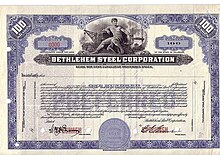Bethlehem Steel

The Bethlehem Steel Corporation , abbreviated to Bethlehem Steel , with headquarters in Bethlehem , Pennsylvania and the last legal seat in Wilmington , Delaware, was the second largest steel producer in the USA after US Steel from Pittsburgh . After its bankruptcy in 2001, the company was dissolved and the remaining assets were sold in 2003 to the International Steel Group , which today belongs to ArcelorMittal . During his playing days, Bethlehem Steel was also one of the largest shipbuilding companies and one of the largest conventional arms companies in the world.
The demise of Bethlehem Steel is often referred to as prominent example of the rejection of the US economy from industrial production and their inability in competition with cheaper insist foreign worker quoted.
founding
The company opened on April 8, 1857 as Saucona Iron Works in South Bethlehem, Pennsylvania. On May 1, 1861, it changed its name to Bethlehem Iron Works . Initially, railroad tracks and armor plates were produced for the United States Navy . In 1899 the Bethlehem Steel Company was taken over; with this in 1904 the Bethlehem Steel Corporation was formed.
In 1904 Charles M. Schwab , a former president of US Steel , who previously worked for the Carnegie Steel Company , joined Bethlehem Steel and together with Joseph Wharton formed the board of directors , in which Schwab assumed the function of president and chairman. Bethlehem Steel rose to prominence in American industry with the installation of the revolutionary gray rolling mill and the production of wide-flange beams , which were first produced in America. They were mainly used in the construction industry , which with the advent of skyscrapers quickly gave Bethlehem Steel the role of the leading supplier to the construction industry. The production method for hardened tool steel , which is widespread worldwide today , was invented at Bethlehem Steel and presented to the public at the EMO 1900.
At the beginning of the 20th century, the group acquired iron ore mines in Cuba and Chile, as well as shipyards throughout the United States. In 1913, Bethlehem Steel acquired the Fore River Shipbuilding Company of Quincy , Massachusetts , which made Bethlehem Steel the world's leading shipbuilder .
In 1916, Eugene Grace became President of the company, which he ran until 1960. In the 1920s, a number of other steel producers were acquired and Bethlehem Steel produced building materials for numerous important buildings, such as B. Rockefeller Center and Madison Square Garden in New York City or for the Golden Gate Bridge in San Francisco . For the publicity of Bethlehem Steel had some time Ivy Lee .
The steel for the US armed forces

During the First and Second World Wars, Bethlehem Steel was the main supplier of armor plates and artillery for the US armed forces .
During World War II, 180,000 of the 300,000 employees in the Bethlehem Shipbuilding Corporation shipyards produced a total of 1,121 ships, more than any other shipbuilder during this period. After the war, a wide range of sectional steels and forged steels were produced for the construction industry and the military, for power generation and other steel producers. The number of employees fell to 121,000 by 1964.
The peak of steel production was reached in the 1950s with around 23 million tons annually. Arthur B. Homer was the highest paid executive in the United States in 1958 as President of Bethlehem Steel; under his direction the largest factory was built in Burns Harbor , Indiana between 1962 and 1964 .
In competition with foreign competitors
In the mid-1980s, the company's sectional steel market began to disappear. More and more steel products, e.g. B. in bridge and shipbuilding, which were previously made from profile steel, could now be made from cheaper flat steel. New competitors entered the market. Lighter, lower architectural styles, which resulted in less tall buildings that did not require the massive sectional steels, forced Bethlehem Steel to give up its factory at the main Bethlehem location in late 1995. After about 140 years of metal production, Bethlehem Steel stopped its production in Bethlehem.
In the 1980s, the import of cheaper foreign steel began, which reduced Bethlehem Steel's share of the American steel market. In 1982 the company made a loss of US $ 1.5 billion and was forced to close down many businesses. In 1988 profit could be made at short notice. In the 1980s and 1990s, the restructuring of the company continued and other productions were shut down. In 1990 Bethlehem Steel achieved sales of US $ 4.93 billion with 29,600 employees.
Closure and bankruptcy
With the closure of its local operations and the resulting extreme influence on the Lehigh Valley region , Bethlehem Steel decided to revitalize the South Side of Bethlehem and recruited third-party consultants to develop concepts for the re-use of the vast area. The consensus was to rename an area of 660,000 m² to Bethlehem Works in order to develop it for culture, recreation, education, entertainment and retail . The National Museum of Industrial History together with the Smithsonian Institution and the Bethlehem Commerce Center, consisting of 6.5 km² of former industrial property, were built on this site.
In 2001, Bethlehem Steel formally went bankrupt . Two years later, the remains, including the six extensive factories, were acquired by the International Steel Group . This company was taken over by Mittal in 2005 . As a result of the merger of Mittal and Arcelor in 2006, the remaining steelworks are now part of ArcelorMittal .
Trivia
The former American band Grant Lee Buffalo dedicated a song of the same name to the company on their 1996 album "Copperopolis".
literature
- Arundel Cotter: The story of Bethlehem steel . Publisher: The Moody magazine and book company New York, 1916
Web links
- Fortune: "The Sinking of Bethlehem Steel" - the autopsy of a company (in English)
- Website with photos and information about Bethlehem Steel (in English)
